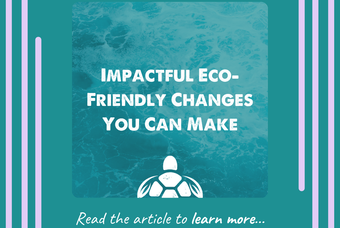The News-Hub/ Articles
Back to Articles
Recommended Articles
Why Are Plastic Bags Bad for the Environment?
We consume a lot. This is no secret. In all our forms of consumption, however, plastic bags are probably what we use the most to carry what we buy. They are cheap and easy for companies to produce or purchase; hence many hand them out to their customers, causing a minimal dent in their profits. This convenience, however, comes at a price; plastic bags are terrible for the environment! Therefore, we should not let these companies put profits over the planet. This means we should not be buying their plastic bags as often, or even using them at all. This article will discuss why plastic bags are so dangerous, and what we can do to limit their use.
How Many Plastic Bags Do We Use?
First of all, when talking about plastic bags, we are not only talking about the standard medium-sized bag you stuff your groceries in. They embody a variety of forms, from the big black bin liners we send to landfill to the tiny sandwich bags you dispose of at lunchtime. They’re everywhere! Some of the facts are startling. Worldwide, 5 trillion single-use plastic bags are used each year. To put this into context, that’s 83 plastic bags per person per year, for every single person on Earth. Shocking, right?
Why Are Plastic Bags Bad for the Environment?
Plastic bags harm the environment upon being produced, as well as when they are disposed of. With regards to production, they contribute to global warming by releasing carbon dioxide into the atmosphere. This is because they are made using plastic, which requires enormous amounts of energy from fossil fuels to be manufactured. In fact, 6% of all the world’s oil resources are used to make plastic, and 40% of that 6% is used to make plastic bags. That’s a hell of a lot of oil for just carrying home our shopping!
After use, where do plastic bags end up? Globally, only 1% of plastic bags are recycled. The rest are left to wreak havoc on the environment. It is estimated that 80 million plastic bags litter the environment every year. Each of these can take 1,000 years to break down. As they do, methane is released into the atmosphere, contributing to global warming much like in the production process. Toxic chemicals also leak into the soil, leaving it less fertile. But plastic bags aren’t just an issue on land: they may end up contaminating the waterways and oceans, which is a perilous proposition for wildlife.

Photo by Leonid Danilov from Pexels
Why is Plastic Bad for the Ocean?
The light physical nature of plastic bags means they can pose fatal risks to animals, especially marine life. They are easily caught by the wind and thus drift into the natural world and pollute our oceans. Even if they are discarded far from the coast, they can be washed away during rainfall into the drains and enter the waterways. This leads them to the sea. The bags are then ingested by the sea creatures who mistake them for food. Once ingested, the creatures often choke on the plastic or pick up internal infections, eventually starving to death as a result. Once the animal carcass has rotted away, the plastic bag escapes from its corpse and the process can be repeated with another animal.
Sea turtles often fall victim to plastic bag pollution; they ingest the bags upon mistaking them for jellyfish, often causing them to die. Whales and various other sea creatures can meet a similar fate. It is estimated that approximately 100,000 marine mammals a year die from ingesting plastic bags alone.
If animals are not consuming plastic bags in their entirety, they are probably still ingesting some of them. When exposed to the elements, plastic bags do not biodegrade completely, but instead photodegrade, meaning they become microplastics that absorb toxins and continue to pollute the environment. It is well known that fish eat thousands of tons of plastic every year, often in the form of microplastics. Therefore, the toxic plastic is transferred up the food chain, finding its way to our dinner plates. Exactly how much of this plastic are we consuming? Frighteningly, it has been confirmed that humans could be consuming between 39,000 and 52,000 plastic particles every year. This poses a still unknown risk to human health.

Photo by Naja Bertolt Jensen on Unsplash
Plastic Bag Solutions
The perils of plastic bag pollution for the air, soil, and ocean are clear. We must do what we can to minimise the amount of plastic bags that we use. Here are a few things we must put into practice.
Recycle
It is difficult to recycle plastic, so very few plastic bags are actually recycled. However, some types of plastic bags are recyclable, so we must recycle them when we can. For example, if they are made from LDPE or HDPE, they can be recycled the standard way in a normal recycling bin. To check whether a type of plastic is recyclable, you can usually find out by checking what is written on the packaging, or by checking with your local authority.
Reuse, and get creative!
Your plastic bag is not recyclable? Make sure you make the most of it before it becomes the environment’s problem! Use it until it can be used no more. Got bored of using the bag for your groceries? Get creative with it! You can use them to cover your plants in the winter to protect them from frost. Scrunch them up and use them as padding for packages you send through the post. Use them to line your cat’s litter tray or even your bird’s cage. Get creative with it!
Use alternatives
Luckily, initiatives are being developed to counteract the problems posed by plastic bags via the use of completely eco-friendly alternatives. Take, for instance, Lucy Hughes’s ingenious invention: biodegradable bags made out of fish waste. These can be put in the compost bin after use and are, of course, fully sustainable. However, they are primarily used as a replacement for plastic sandwich bags. Nevertheless, there are hopes that they will soon widen their scope to include bakery bags and small carrier bags. It is only a matter of time.
While we wait, however, we need something to carry our shopping home with. What can it be if it isn’t plastic? What about paper? After plastic, paper is perhaps the most common material that is used for carrier bags. How do paper bags compare to plastic bags in terms of the environment? Surprisingly, the process of manufacturing paper bags takes more energy, and releases more toxic chemicals, than the production of plastic bags. However, paper, unlike plastic, biodegrades a lot quicker, is a lot more recyclable, and is not as harmful to marine life. A study has revealed that it takes 3 uses of a paper bag to make it more environmentally friendly than its plastic counterpart. That is if it makes it to 3 uses (paper is weaker than plastic, after all)! Nevertheless, as long as the paper bags are treated well and not replaced as frequently as plastic bags, they are the preferable option.
There are a range of reusable alternatives that are more sustainable than plastic, but also sturdier than paper. These include bags made of nylon, mesh, canvas, denim, jute, and cotton. These can often be very trendy, and Purple Turtle’s very own Luxury Corduroy Shopping Bag is a prime example of how fashionable saving the planet can be. Bags such as this are often made from renewable resources and are much more biodegradable. They are also heavier than plastic, so are less likely to get tangled up with the turtles if your bag did somehow find its way into the ocean!

Photo by Priscilla Du Preez on Unsplash
We must, however, reuse alternatives made from the above materials just as much as we might reuse plastic bags. Their durability and sturdiness often mean that they can take quite a bit of energy to produce. Therefore, to make them the true, eco-friendly plastic bag alternatives they deserve to be, ensure they are your eternal shopping companions.
Ban plastic bags
To avoid the plastic bag fiasco altogether, we should be looking to ban them altogether. You may already be aware that steps are being taken by some governments to reduce the use of plastic bags. 69 countries of the world have passed a full or partial ban on their usage. The continent of Africa is leading the way in exemplary fashion, standing as the continent in which most countries have banned the production of plastic bags, with 25 countries in total. 32 countries have opted to charge a fee (or levy a tax) for their use. However, the levy is often an insignificant amount and does not deter people from simply binning their plastic bag or forgetting to bring it out shopping with them. If they cannot ban the bags completely and instead opt for a levy, we should encourage governments to raise the price of plastic bags. This would encourage more frequent reuse.
Let’s Take Action Today
The trillions of plastic bags that we use, and the damage that each of these potentially has on the environment, is something we must all seek to avoid. If you have a plastic bag that isn’t recyclable, focus on reusing it as much as possible, and don’t forget to take it to the supermarket with you! If it is recyclable, still reuse it as much as possible before it is recycled (the next owner might not be so eco-conscious!) If you have a (more preferable) sustainable alternative, you are definitely taking steps in the right direction, but it’ll all be for nothing if you also forget to reuse those as well. In short: reuse the life out of every bag you have!
Got any creative reuse strategies? Any heroic sustainable bag tales to tell? Feel free to comment your thoughts below!
Empty content. Please select category to preview











0 comments. Write a comment